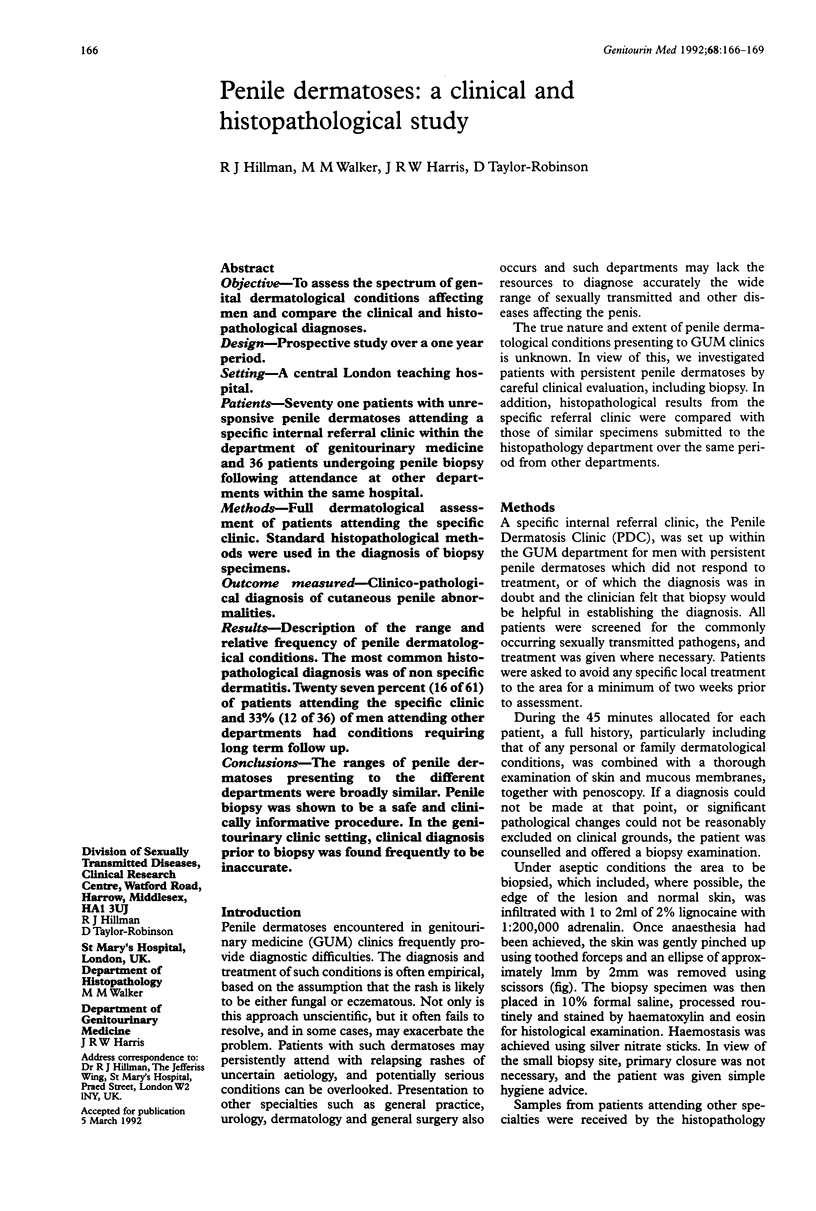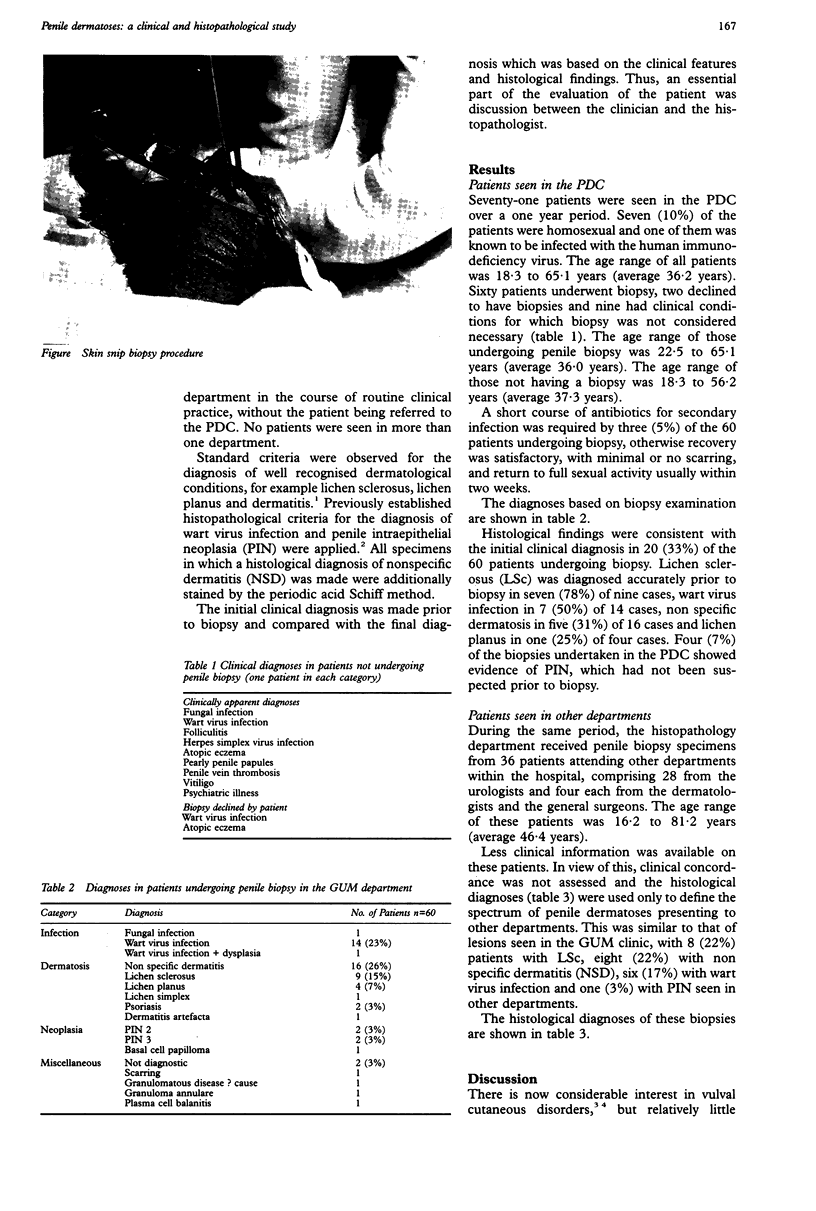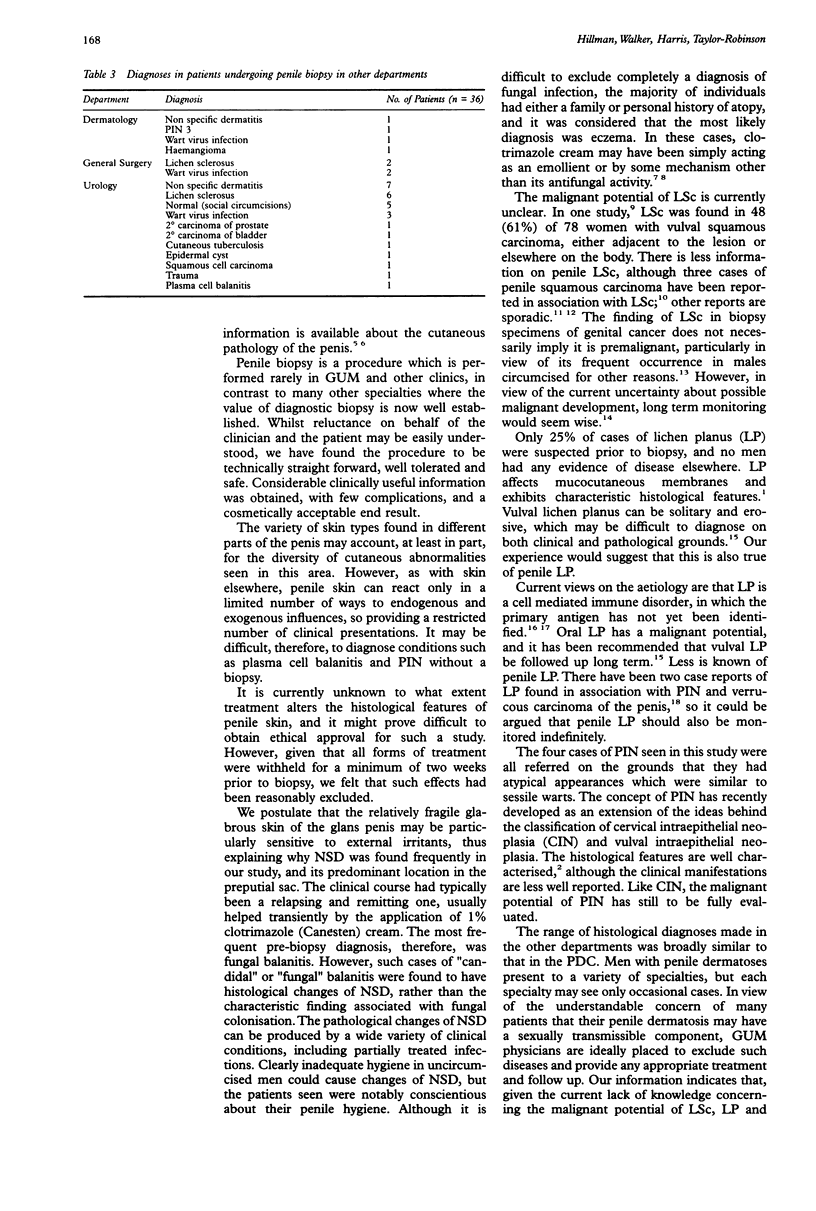Abstract
OBJECTIVE--To assess the spectrum of genital dermatological conditions affecting men and compare the clinical and histopathological diagnoses. DESIGN--Prospective study over a one year period. SETTING--A central London teaching hospital. PATIENTS--Seventy one patients with unresponsive penile dermatoses attending a specific internal referral clinic within the department of genitourinary medicine and 36 patients undergoing penile biopsy following attendance at other departments within the same hospital. METHODS--Full dermatological assessment of patients attending the specific clinic. Standard histopathological methods were used in the diagnosis of biopsy specimens. OUTCOME MEASURED--Clinico-pathological diagnosis of cutaneous penile abnormalities. RESULTS--Description of the range and relative frequency of penile dermatological conditions. The most common histopathological diagnosis was of non specific dermatitis. Twenty seven percent (16 of 61) of patients attending the specific clinic and 33% (12 of 36) of men attending other departments had conditions requiring long term follow up. CONCLUSIONS--The ranges of penile dermatoses presenting to the different departments were broadly similar. Penile biopsy was shown to be a safe and clinically informative procedure. In the genitourinary clinic setting, clinical diagnosis prior to biopsy was found frequently to be inaccurate.
Full text
PDF



Images in this article
Selected References
These references are in PubMed. This may not be the complete list of references from this article.
- Arumainayagam J. T., Sumathipala A. H. Value of performing biopsies in genitourinary clinics. Genitourin Med. 1990 Oct;66(5):407–407. doi: 10.1136/sti.66.5.407. [DOI] [PMC free article] [PubMed] [Google Scholar]
- Bain L., Geronemus R. The association of lichen planus of the penis with squamous cell carcinoma in situ and with verrucous squamous carcinoma. J Dermatol Surg Oncol. 1989 Apr;15(4):413–417. doi: 10.1111/j.1524-4725.1989.tb03247.x. [DOI] [PubMed] [Google Scholar]
- Barrasso R., De Brux J., Croissant O., Orth G. High prevalence of papillomavirus-associated penile intraepithelial neoplasia in sexual partners of women with cervical intraepithelial neoplasia. N Engl J Med. 1987 Oct 8;317(15):916–923. doi: 10.1056/NEJM198710083171502. [DOI] [PubMed] [Google Scholar]
- Bart R. S., Kopf A. W. Tumor conference No 18: squamous-cell carcinoma arising in balanitis xerotica obliterans. J Dermatol Surg Oncol. 1978 Aug;4(8):556–558. doi: 10.1111/j.1524-4725.1978.tb00500.x. [DOI] [PubMed] [Google Scholar]
- Bingham J. S. Carcinoma of the penis developed in lichen sclerosus et atrophicus. Br J Vener Dis. 1978 Oct;54(5):350–351. doi: 10.1136/sti.54.5.350. [DOI] [PMC free article] [PubMed] [Google Scholar]
- Doré B., Irani J., Aubert J. Carcinoma of the penis in lichen sclerosus atrophicus. A case report. Eur Urol. 1990;18(2):153–155. doi: 10.1159/000463895. [DOI] [PubMed] [Google Scholar]
- Griffiths C. E., Voorhees J. J., Nickoloff B. J. Characterization of intercellular adhesion molecule-1 and HLA-DR expression in normal and inflamed skin: modulation by recombinant gamma interferon and tumor necrosis factor. J Am Acad Dermatol. 1989 Apr;20(4):617–629. doi: 10.1016/s0190-9622(89)70073-6. [DOI] [PubMed] [Google Scholar]
- Holt R. J., Newman R. L. Laboratory assessment of the antimycotic drug clotrimazole. J Clin Pathol. 1972 Dec;25(12):1089–1097. doi: 10.1136/jcp.25.12.1089. [DOI] [PMC free article] [PubMed] [Google Scholar]
- Leibowitch M., Neill S., Pelisse M., Moyal-Baracco M. The epithelial changes associated with squamous cell carcinoma of the vulva: a review of the clinical, histological and viral findings in 78 women. Br J Obstet Gynaecol. 1990 Dec;97(12):1135–1139. doi: 10.1111/j.1471-0528.1990.tb02502.x. [DOI] [PubMed] [Google Scholar]
- Ridley C. M. Chronic erosive vulval disease. Clin Exp Dermatol. 1990 Jul;15(4):245–252. doi: 10.1111/j.1365-2230.1990.tb02083.x. [DOI] [PubMed] [Google Scholar]
- Schaller K. In vitro antibacterial activity of different clotrimazole formulations. Chemotherapy. 1982;28 (Suppl 1):32–36. doi: 10.1159/000238149. [DOI] [PubMed] [Google Scholar]



